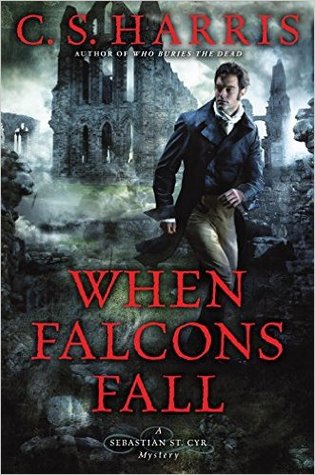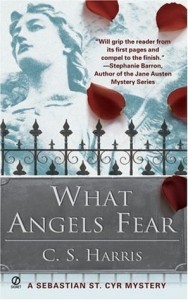 When Falcons Fall (Sebastian St. Cyr, #11) by C.S. Harris
When Falcons Fall (Sebastian St. Cyr, #11) by C.S. Harris Formats available: hardcover, ebook
Series: Sebastian St. Cyr #11
Pages: 368
Published by NAL on March 1st 2016
Purchasing Info: Author's Website, Publisher's Website, Amazon, Barnes & Noble, Kobo, Bookshop.org
Goodreads
The much-anticipated new entrée in the Sebastian St. Cyr “simply elegant”* historical mystery series, from the national bestselling author of Who Buries the Dead and Why Kings Confess.
Ayleswick-on-Teme, 1813. Sebastian St. Cyr, Viscount Devlin, has come to this seemingly peaceful Shropshire village to honor a slain friend and on a quest to learn more about his own ancestry. But when the body of a lovely widow is found on the banks of the River Teme, a bottle of laudanum at her side, the village’s inexperienced new magistrate turns to St. Cyr for help. Almost immediately, Sebastian realizes that Emma Chance did not, in truth, take her own life. Less easy to discern is exactly how she died, and why. For as Sebastian and Hero soon discover, Emma was hiding both her true identity and her real reasons for traveling to Ayleswick. Also troubling are the machinations of Lucien Bonaparte, the estranged brother of the megalomaniac French Emperor Napoleon. Held captive under the British government’s watchful eye, the younger Bonaparte is restless, ambitious, and treacherous. Sebastian’s investigation takes on new urgency when he discovers that Emma was not the first, or even the second, beautiful young woman in the village to die under suspicious circumstances. Home to the eerie ruins of an ancient monastery, Ayleswick reveals itself to be a dark and dangerous place of secrets that have festered among the villagers for decades—and a violent past that may be connected to Sebastian’s own unsettling origins. And as he faces his most diabolical opponent ever, he is forced to consider what malevolence he’s willing to embrace in order to destroy a killer.
*Lisa Gardner
My Review:
I read the first five books in this series several years ago, and then lost track. They are excellent books, but I ran into the “so many books, so little time” problem, and for some reason this series fell by the wayside.
Having finished the latest book in the series, When Falcons Fall, I can see that this was a terrible mistake – the series is every bit as awesome as I remember.
Of course, that I enjoyed this one so much after a reading hiatus of five years or so says that you probably don’t need to have read the whole series to enjoy the latest entry. In my case, it makes me want to go back and pick up the ones that I missed.
This series is unusual is that it is a Regency series that is not a romance, although there is a very slow-burning romantic subplot in it after all. Instead, is it a historical mystery series, where the private detective is a dabbling aristocrat who is using his investigations as a productive but unorthodox way of dealing with PTSD after the Napoleonic Wars.
Sebastian St. Cyr is a haunted man. He is also a man clandestinely searching for his identity. At the beginning of the series, he believes that he is the third son and accidental heir of Earl of Herndon and that his mother is dead. As the series progresses, while the legal facts don’t change, Devlin discovers that the truth is otherwise. His mother is very much alive, and whoever his biological father may have been, it certainly wasn’t the Earl. Not that the Earl is planning to expose this fact – Devlin’s two older brothers are dead, and he is the only heir to the title left.
But that leaves Devlin searching for his real antecedents in secret. In When Falcons Fall, his quest has taken him to Aylesworth-on-Teme. The grandmother of one of his fellow soldiers lives there, and Devlin has a final present for her from her late son. Devlin also wants to discover what, if anything is known about his friend’s own father, for Viscount Devlin and his dead friend looked enough alike to be twins. Enough alike that Jamie took a bullet that was clearly aimed at Devlin.
As usual for Devlin, when he reaches Aylesworth his own concerns take a backseat to the investigation he gets dragged into, only to have them circle around and become part of the murder he can’t resist solving.
Emma Chance is dead. Found with an empty laudanum bottle in her hand, and no obvious wounds, the local constable pushes for a rush to judgment of suicide. But the local Squire is not convinced, and that’s where Devlin comes in.
Emma Chance was certainly murdered. She could not have walked to the site of her death without getting mud on her extremely clean boots up to her ankles. Someone obviously staged her death scene. At first, the question is, who? But as Devlin looks into the death of Emma Chance, he discovers that he does not know whose death he is investigating.
Whoever the young widow who expertly sketched people and places in Aylesworth might have been, she certainly wasn’t the widow Emma Chance, because Emma Chance doesn’t exist.
Emma Chandler is dead. She came to Aylesworth to investigate her own identity. A search that parallels Devlin’s. After discovering the identity of her mother, Emma is in Aylesworth searching for the identity of her mother’s rapist among the local gentry.
As Devlin follows Emma’s trail, he can’t help but think that her search upset the local aristocracy. His search discovers a pattern of young women who were believed to have committed suicide, just as Emma was originally suspected of doing, on extremely flimsy evidence, combined with the local desire to sweep the horrible events under a rug, just as they have other, much worse crimes.
And also other much better ones. Aylesworth is just close enough to the coast to be useful for smuggling, and it’s a thriving trade while France is blockaded and French goods are embargoed. It’s entirely possible that poor Emma was just in the wrong place at the wrong time, and got in the way of the local “free traders”.
Or she ran afoul of the local spy community. Or rather, the not-so-local spy community. Lucian Bonaparte, brother of Napoleon, is in residence in the neighborhood. And as Napoleon is fading in power, it is almost certain that he is looking for some rapprochement with his estranged brother. There are French spies in the area, passing messages between the Corsican brothers. And there are English spies in the woods, spying on the French spies. It is all too plausible that someone did not want to be seen in the middle of either treason or espionage.
But neither of these new possibilities explain the earlier deaths of young women. It seems highly unlikely that there are two murderers roaming in this small village. And yet, whatever is not impossible, must be the truth.
Can Devlin find that truth before it is too late?
Escape Rating A+: After a five-year reading hiatus on my part, as soon as I turned the first page I was right back in the thick of this series, and it took hours after I turned the last page to come out of the resulting book hangover.
The overarching story of the series is Devlin’s search for identity. He solves murders to fight his demons, but he is always looking for clues to who he really is and where he comes from. That gaping void in his center, where his certainty used to be and no longer is, drives him, and it drives him hard. Every time he tracks down one clue, two more spring up in its wake.
And he must always remember to keep up the charade at all costs. Whoever he knows himself to be, he must retain his identity as Viscount Devlin. There is no other heir. And it’s not as if he is lying to his legal father, the Earl has known the secret all along, and has caused no end of damage in his attempts to manipulate Devlin by withholding that truth. To say that the family is dysfunctional, is an understatement. It is easy to sympathize with Devlin’s mother, who pretended to die in order to escape.
So Devlin sees himself in Emma. And the locals certainly see his friend Jamie in him. Everyone is all too aware that Devlin and the late and well-known local must be secretly related, and no one dares comment directly on the resemblance. Unfortunately for Devlin, Jamie’s true father is also unknown, and even Jamie’s twin sister only has hints of who might have fathered Devlin, Jamie and herself.
Emma’s death digs up local dirt going back decades. In this small community, the past is definitely not over. It is not even slightly past. Under every rock Emma, and Devlin, uncover a new/old snake. One of the neat things in this story is the way that the past is tied into historic events that are still having legal and economic repercussions decades later. Devlin’s wife, Hero, is researching the effect of the Enclosure Act on small rural communities, expecting to find a lot of dirt, even to the point of old murders. She doesn’t expect to find new murders. Or nearly be murdered herself.
Hero St. Cyr is every bit as fascinating a character as her husband. At the very beginning of the series, Hero and Devlin are enemies. Her father is trying to either murder Devlin or get him convicted of something. As the series continues, Hero and Devlin begin to find themselves on the same side in some of his cases, however reluctantly. Their shift from enemies to frenemies to allies to marriage to love is slow and moves fitfully. With Hero’s unusual education and extreme independent-mindedness, she is the perfect partner for Devlin. That it takes both of them a long time and a lot of crises to realize that makes their marriage and partnership that much sweeter to watch.
 And it is Hero’s research that provides so much of the interest and so many of the clues in this puzzling case. If you like historical mysteries with unusual heroes and heroines, you’ll be absorbed by this series. Start your dark journey to the Regency with What Angels Fear.
And it is Hero’s research that provides so much of the interest and so many of the clues in this puzzling case. If you like historical mysteries with unusual heroes and heroines, you’ll be absorbed by this series. Start your dark journey to the Regency with What Angels Fear.
